Platycerium
Water Test
Below are (or will be) a series of photos displaying two Platyceriums pups from the same mother, and about the same maturity. They were mounted March 20, 2015 on the North side of a storage shed with partial shade. The one on the left will be watered daily with 16 oz of RO, drinking, water with no chlorne and a PH of about 6. The one on the right is watered daily with 16 0z of city tap water which includes chlorine and a PH of 7.6. Prior to being cut from the mother, they were watered with city tap water. During this test, observation, neither one was given fertilizer or Super Thrive vitamins. Before the test, and during the test, the platyceriums receive ample moisture from night time dew near the beach.
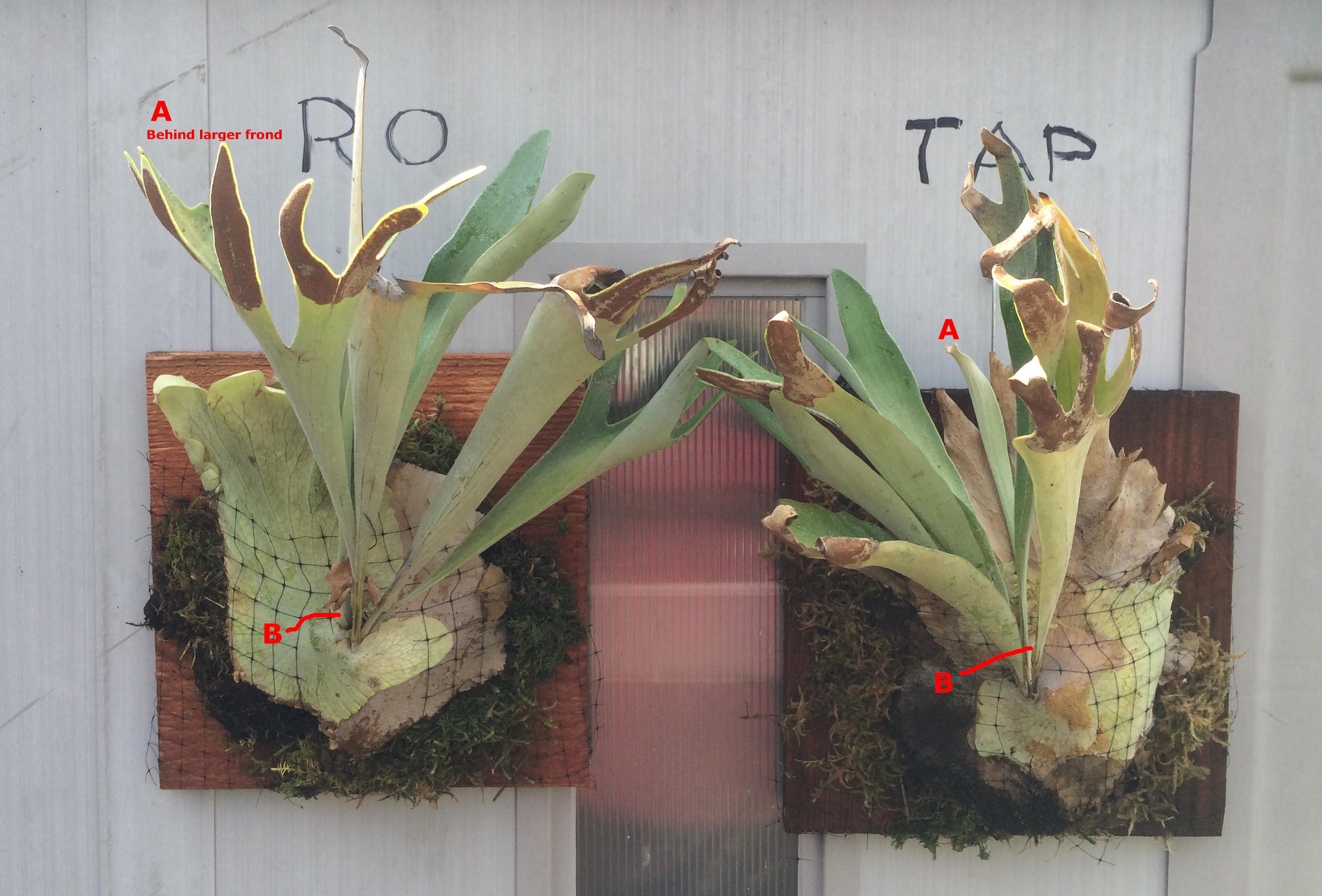
Photo taken March 21, 2015
Fronds A & B are labeled for comparison below. The larger fronds are
blocking view of fronds A & B and they are removed below.
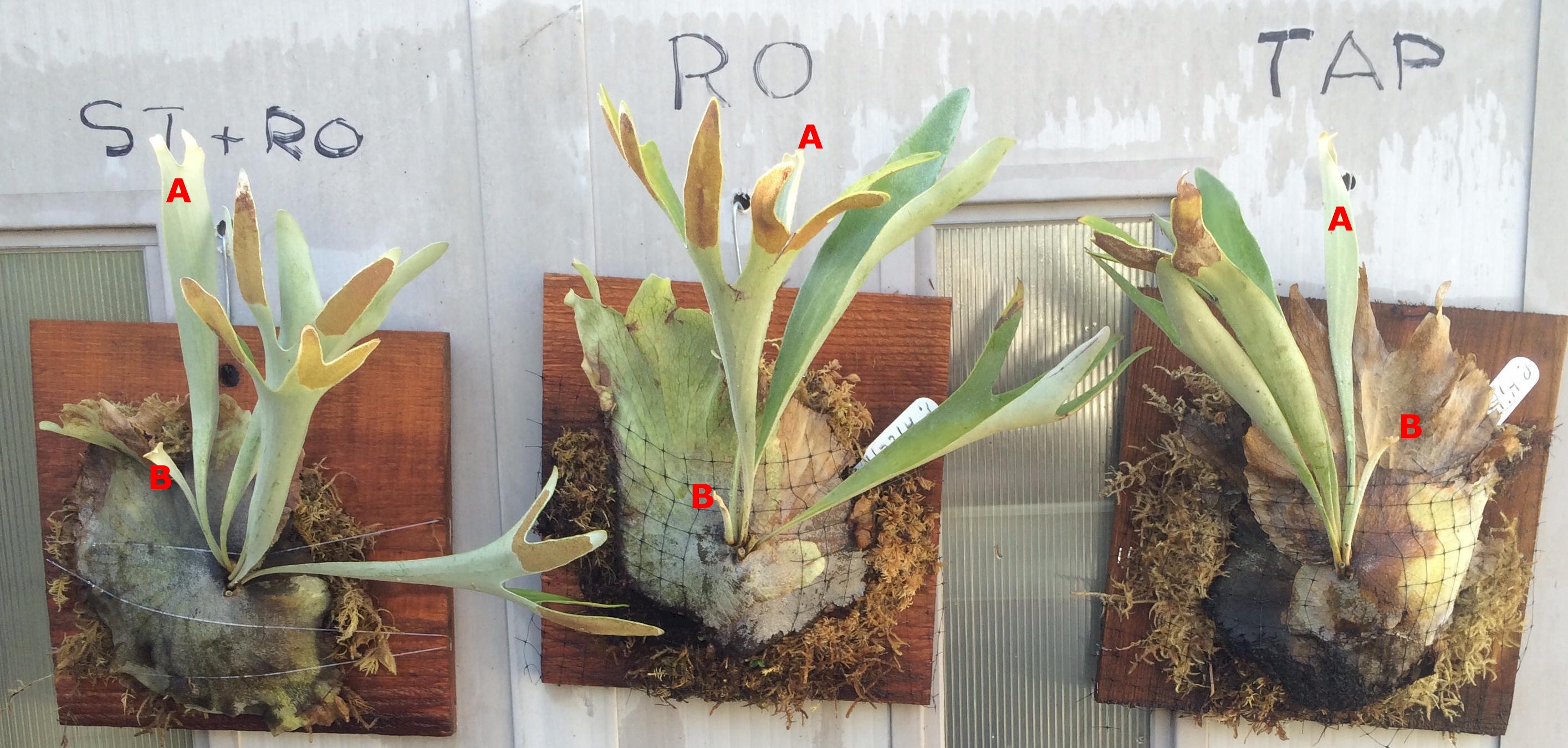
Photo taken April 9, 2015. (19 days)
Some growth noticeable, but not conclusive from above photo.
A third group was added. A similar pup from same mother plant and watered daily with RO water with 1/4 tsp of 20-20-20 orchid food and a couple drops of Super Thrive mixed in a 2 gal pressure spray bottle. All three plants have had older fertile fronds removed since the top photo was taken to better observe new growth.
OBSERVATIONS - All three plants have a new fertile
frond developing that were hardly visible on earlier photo. The fronds
were partially hidden by older fronds. The fertile fronds show 4 and 5
fingers and when they mature they may show 7
finger fronds.
At this date, the TAP water fern with frond A is the
tallest.
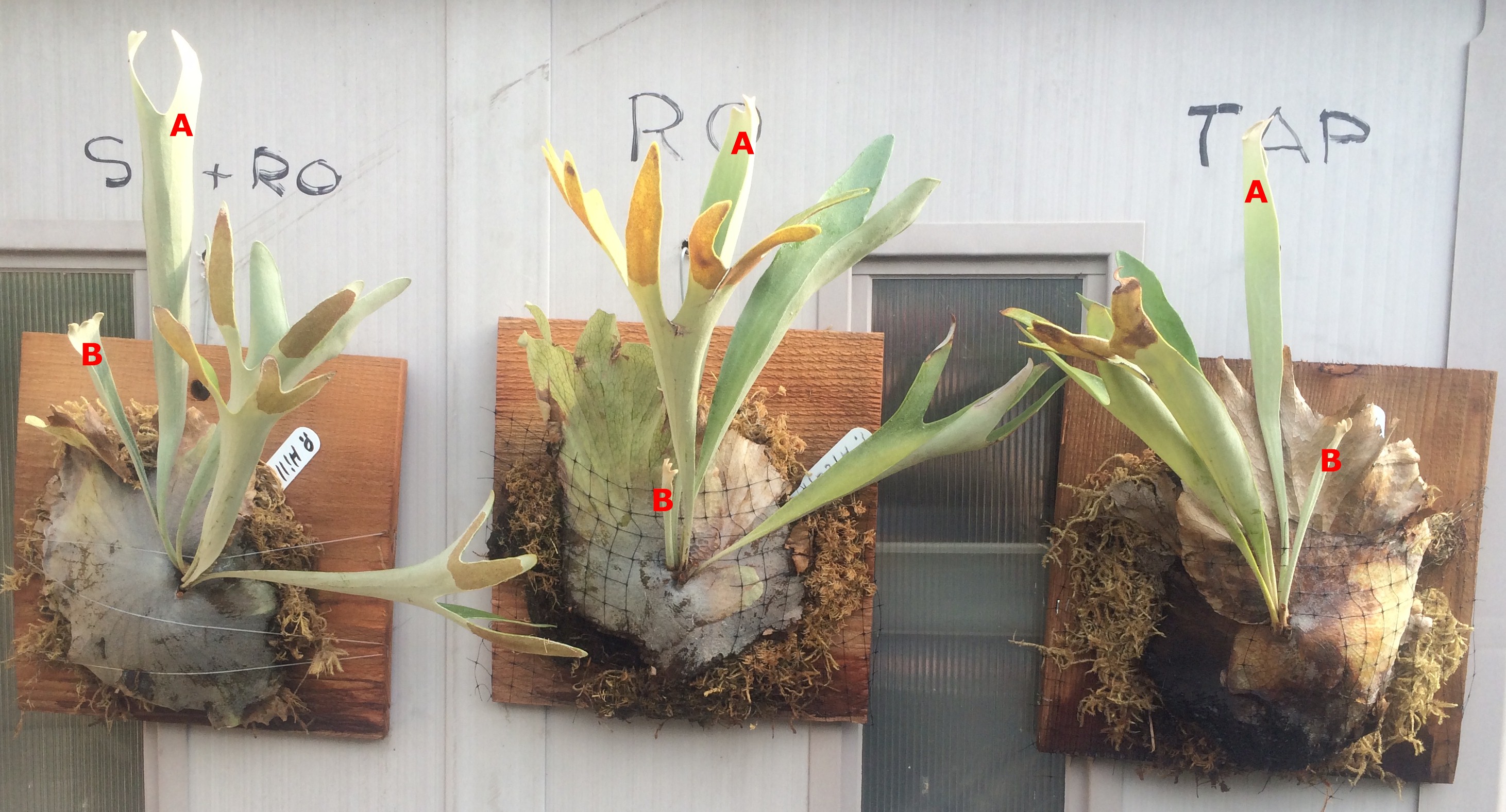
Photo taken April 23, 2015
It has been 14 days since adding the ST+RO plant and to our surprise we are starting to see measurable
results. We have identified two fronds, A and B on each plant.
When comparing these fronds to the above photo you can see the growth in 14
days. As expected the RO plant is doing better than the TAP plant, and
the ST+RO plant is doing better than the RO plant when comparing this photo
the the photo above.
-
The TAP plant shows frond A growing from the bottom of the letter A in TAP to almost the top of the letter. About 1.5 inches
-
The RO plant show frond A growing fro about 2 inches below the letter O in RO to the top of the letter O. Frond A in plant RO has doubled the growth of plant TAP. About 4 inches
-
Frond A on the ST + RO plant has grown from the center of the T to about 4 inches above the letter T for a total growth of about 5 inches. Also, the finger tips have really started to take shape relative to the other two plants.
-
Frond letter B on the TAP plant has grown almost 3 inches or about 40% growth.
-
Frond letter B on the RO plant possibly 1 inch for a 100% growth in 14 days.
-
Frond letter B on plant RO + ST has grown about 2.5 inches for possibly 130% growth and the finger tips are starting to form.
-
Fern TAP with frond A is now the shortest of the three test samples.
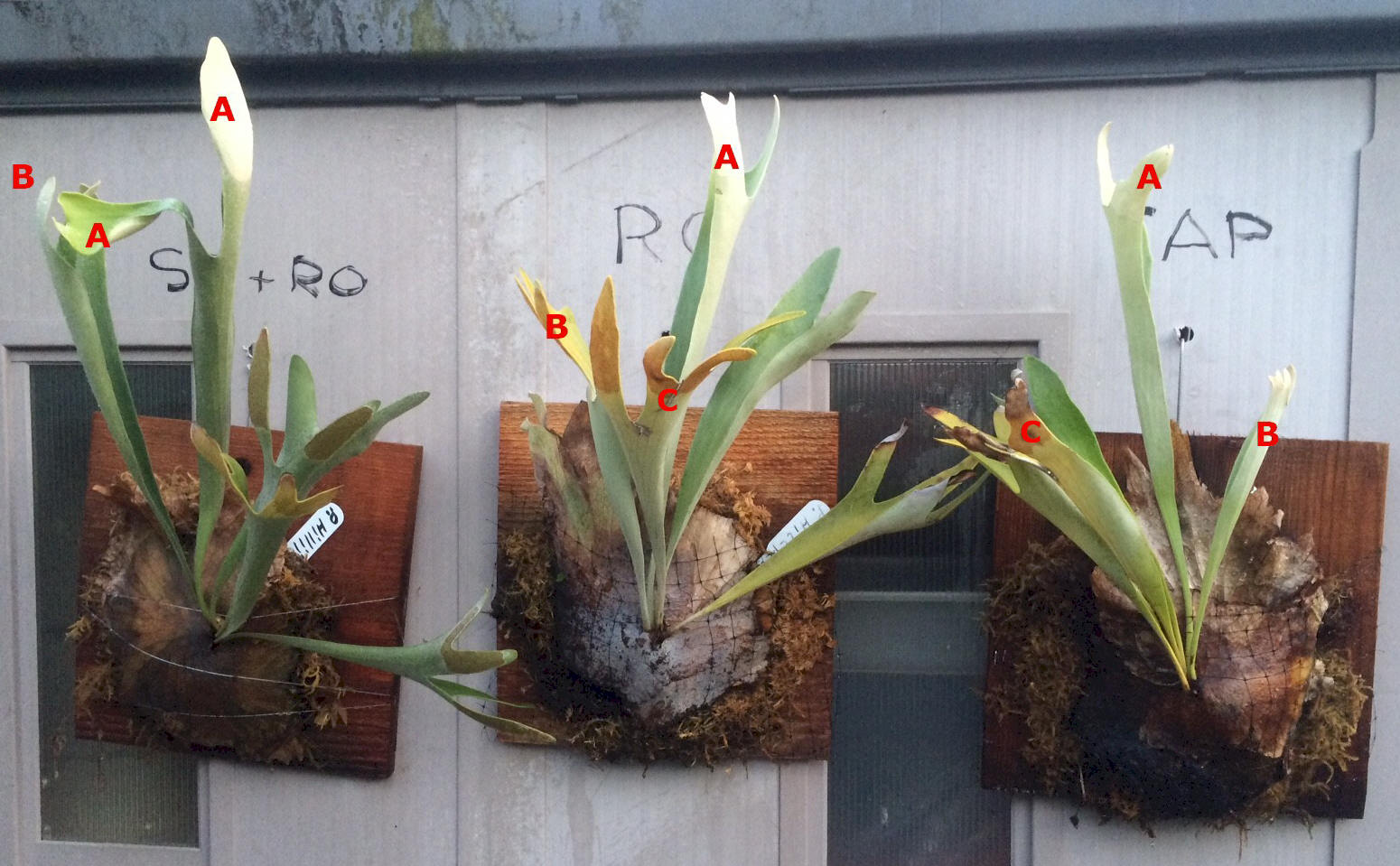
Photo taken May 24, 2015
-
It has been 44 days since the beginning of the water test and the results appear conclusive.
-
The TAP plant shows frond A just slightly larger than the photo taken 30 days earlier on April 23. It appears that the length of frond A has reached is maximum length. Frond B has grown abut 4 or 5 more inches.
-
The RO plant has grown frond A about 6 more inches while frond B which was just starting to develop 30 days ago has about 9 or 10 inches and is larger then the B frond on the TAP plant. If we consider the TAP plant growing 100%, then we should conclude the RO plant has grown about 150%
-
The RO+ST plant frond A may have reached is full grown length and is maybe 6 inches taller than April 23 photo. A spore patch is forming on frond A, Frond B has grown maybe 10 inches in 30 days. Frond B also has 3 well defined fingers (not viewable in photo) which is a new event for all the platys. A new frond is starting at the bud.
-
Observing the older, unlabeled fronds, we can assume they may represent the expected length of the new fronds The new fronds in all 3 plants were watered daily and it is assumed that is why all three plants exhibit longer fronds than expected.
-
Fronds labeled C are removed on the photo below.
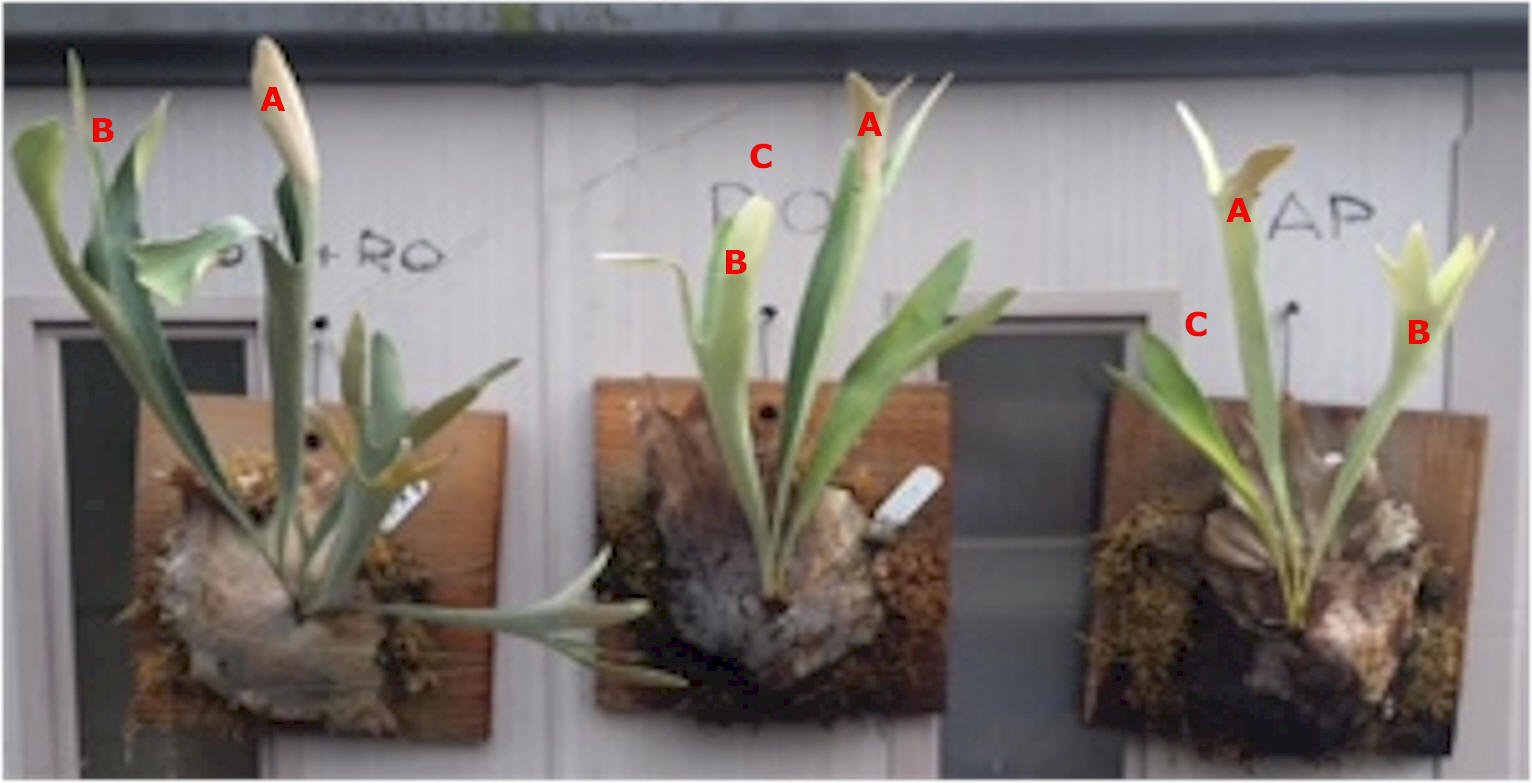
Photo taken June 59 2015
It has been 79 days since the beginning of the test
-
Fronds lettered C have been removed from earlier photo to make it easy to see new growth.
-
Fronds labeled A appear to have not grown in last month since they reached maturity. The only exception may be the ST+RO plant shows a little growth in length.
-
Fronds labeled B have displayed more growth, with the ST+RO plant showing the most growth.
CONCLUSION Platycerium hillii cv Jimmie grows better on low PH, chlorine free RO water which is the about the same as bottled drinking water, or rain water. The difference is probably about 40 percent increase in growth over citu tap water. With the addition of SuperThrive, a vitamin supplement, the expected growth is about 100 percent more than city tap water. An unexpected development is all three plants grew mew fronds larger than expected, possibly from the daily watering. Since the plants are mounted on boards, the water flows through and there is no problem with rot caused from over watering. I don't believe you can over water a platycerium that is attached to a tree or board since the excess water flows through the plant and drains out.
ABOUT MY RO WATER SYSTEM The system is a 75 gallon a day Reverse Osmosis system purchased on Amazon for about $160. I have it providing water to two tanks. The first is a small 3 or 4 gallon pressurized tank that comes with the system. The pressurized tank provides a pressurized flow from the RO system. The second tank is a plastic 55 gallon surplus drum. I tried to make it a pressurized tank but I was not able to get a good seal and added a 120 volt RV water pump. This works perfectly. The only problem is that for every gallon of RO water, there is 5 gallons of waste water going down the drain. Since we are having a serious drought in California, I added 5 more plastic surplus drums to recycle the waist water to other parts of the garden and lawn. The five 55 gallon drums are connected with siphon hoses keeping the water level the same in all 5 drums. These 5 drums required a second 120 volt RV water pump. The only problem is the volume of water is too low to water a lot of area fast. Works great in a a small green house, but the lawn is a different situation. Rather than buying a $1000 high volume water pump, I have chosen to live with the low water volume and take short naps while hand watering the lawn :-)